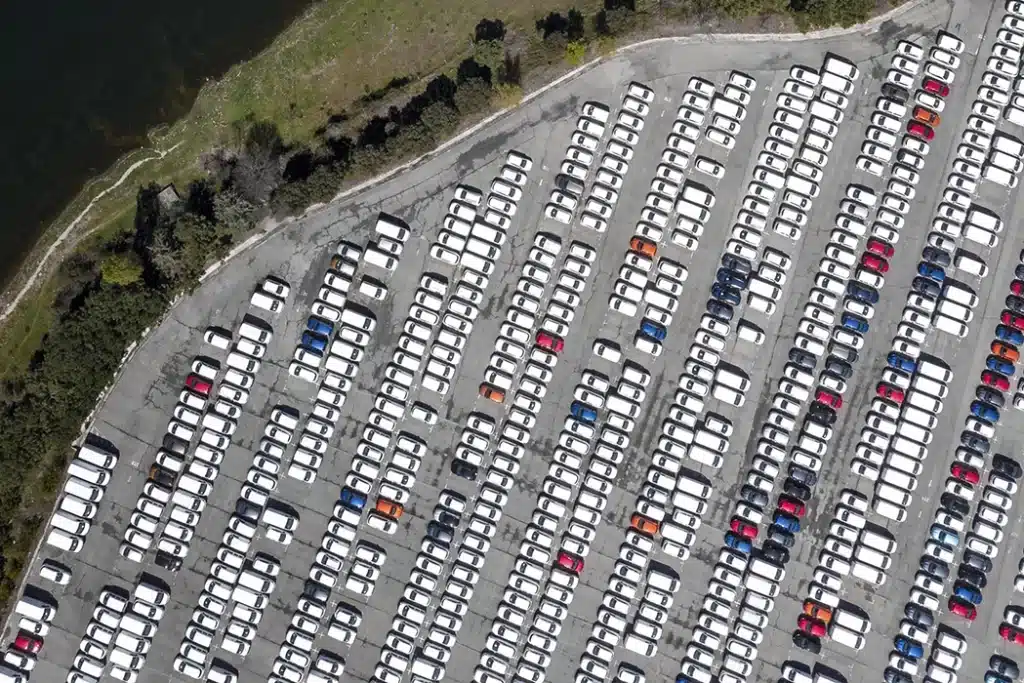In today’s fleet operations, data is one of the most valuable assets—yet many fleets struggle with fragmented systems that don’t communicate effectively. Disconnected software, outdated manual processes, and isolated data sources create inefficiencies, delays, and unnecessary costs.
Fleet managers often rely on multiple platforms for vehicle tracking, maintenance scheduling, fuel management, compliance monitoring, and dispatching. However, when these systems operate in silos, they require manual data entry, increase human error, and slow down decision-making.
A study found that employees spend nearly 30% of their workweek searching for information or performing duplicate data entry, leading to wasted time and lost productivity.
The impact of disconnected fleet systems extends beyond inefficiencies. Unintegrated maintenance logs can cause delayed repairs, increasing vehicle downtime. Inaccurate compliance tracking can result in regulatory fines. Dispatch teams working without real-time data struggle with poor route planning, increasing fuel costs and missed deadlines.
Without a unified system that connects fleet data seamlessly, businesses face operational bottlenecks, rising costs, and missed opportunities for optimization. This article explores how smart fleet integration eliminates data silos, automates workflows, and transforms fleet operations for greater efficiency and profitability.
The Hidden Costs of Disconnected Fleet Systems
Fleet operations rely on multiple systems to track vehicles, monitor fuel usage, schedule maintenance, and manage compliance. When these systems operate independently, businesses experience data silos, leading to inefficiencies, increased costs, and reduced operational control.
Below are some of the biggest challenges fleets face due to disconnected systems:
1. Manual Data Entry and Inconsistent Information
When fleet managers rely on separate platforms that don’t sync in real time, employees must manually enter data across multiple systems. This process introduces errors, wastes time, and causes discrepancies that can lead to poor decision-making. A logistics company, for example, may have fuel transactions recorded in one system, driver logs in another, and maintenance schedules in a third—requiring hours of manual reconciliation.
2. Delayed Maintenance and Increased Downtime
Disconnected maintenance tracking often results in missed service reminders and delayed repairs, increasing the risk of breakdowns and costly emergency fixes. Without integration between telematics, work order management, and diagnostic tools, fleet managers lack real-time insights into vehicle health, leading to unexpected failures that could have been prevented.
In industries like construction and logistics, equipment downtime translates to missed deadlines, project delays, and financial losses. A fleet that integrates vehicle diagnostics with automated maintenance scheduling can proactively address issues before they escalate.
3. Inefficient Dispatching and Route Planning
When dispatch systems don’t communicate with real-time GPS tracking, drivers receive inefficient routes, causing delays and excessive fuel consumption. A last-mile delivery service, for instance, might struggle with traffic congestion because dispatchers lack updated ETAs.
With integrated routing software, businesses can optimize schedules, dynamically reroute drivers based on real-time conditions, and reduce unnecessary mileage—improving efficiency and on-time performance.
4. Compliance Risks and Regulatory Fines
Meeting regulatory requirements for Hours of Service (HOS), vehicle inspections, and safety compliance is challenging when fleet data is scattered across multiple platforms. If compliance logs aren’t updated automatically, fleets risk violations, fines, and potential legal liabilities.
For example, commercial carriers operating across state lines must track driver logs, vehicle inspections, and fuel tax reports. When this data isn’t centrally managed, companies may fail audits or incur penalties due to missing or inaccurate records.
5. Limited Visibility and Poor Decision-Making
Fleet managers need a complete picture of operations to make informed decisions. When fuel efficiency data is stored in one system, maintenance logs in another, and driver safety reports elsewhere, managers cannot analyze trends or identify areas for cost reduction.
A fleet without centralized data may struggle to see which vehicles are underutilized, which drivers need additional training, or how fuel expenses fluctuate across different routes. By integrating these systems, businesses can access real-time insights to improve efficiency, lower costs, and enhance productivity.
Next: How Fleet Integration Eliminates These Challenges
Addressing these challenges requires a seamless data ecosystem where all fleet management systems communicate with each other. In the next section, we’ll explore how integration solutions connect vehicle tracking, maintenance, compliance, and dispatching into a single platform—eliminating inefficiencies and transforming fleet operations.
How Fleet Integration Eliminates Operational Inefficiencies
Breaking down data silos through system integration enables fleets to optimize workflows, improve decision-making, and lower costs.
By connecting telematics, maintenance tracking, fuel management, compliance, and dispatching systems into a centralized platform, fleets gain real-time visibility and automated workflows that drive efficiency.
1. Automating Data Flow Across Systems
With integrated systems, data flows seamlessly between platforms, eliminating the need for manual data entry and reducing human errors. Instead of fleet managers having to reconcile trip logs, fuel transactions, and maintenance records manually, a unified platform ensures that all records are updated automatically.
For example, a logistics fleet using integrated fuel management and telematics can track fuel efficiency in real time, automatically cross-referencing fuel card transactions with vehicle locations to detect unauthorized purchases or potential fraud.
2. Real-Time Maintenance Alerts and Preventive Repairs
When maintenance tracking is connected with telematics and diagnostic tools, fleet managers receive automated alerts when a vehicle requires servicing—reducing downtime and extending asset lifespan.
For industries like construction and heavy equipment, this integration ensures proactive servicing rather than reactive repairs, preventing costly breakdowns that can halt projects. Instead of relying on outdated maintenance logs, businesses can set up automated work orders when vehicle diagnostics detect early warning signs.
3. Optimized Dispatching and Route Planning
Integrated GPS tracking and route optimization software enables fleets to adjust routes in real time, avoiding traffic delays and minimizing fuel consumption.
For last-mile delivery, an AI-driven dispatch system can dynamically reassign jobs based on driver proximity, current traffic conditions, and customer ETAs—ensuring on-time deliveries and reducing idle time.
In field service operations, dispatchers can use real-time location data to assign technicians based on their nearest availability, reducing unnecessary travel and improving response times for urgent service calls.
4. Compliance and Regulatory Reporting Made Easy
Automating compliance reporting helps fleets stay ahead of safety regulations, vehicle inspections, and Hours of Service (HOS) requirements without added administrative burden.
For example, commercial fleets using integrated electronic logging devices (ELDs) can automatically track driver hours, preventing HOS violations that could lead to fines. Additionally, vehicle inspection data can sync directly with compliance platforms, ensuring that fleets meet Department of Transportation (DOT) and industry standards without manual tracking.
5. Centralized Fleet Data for Smarter Decision-Making
A fully integrated fleet management system provides a single source of truth, allowing managers to make data-driven decisions that optimize resources and cut costs.
For example, a fleet can track vehicle utilization trends and determine which assets are underperforming or underutilized, helping businesses decide whether to reallocate, downsize, or invest in additional vehicles.
By analyzing integrated fuel reports, maintenance schedules, and driver safety data, fleet operators can uncover trends that lead to cost savings, such as identifying drivers who require additional coaching or pinpointing which vehicles consume the most fuel.
Next: The ROI of Fleet System Integration
With connected fleet systems, businesses experience lower operating costs, improved safety, and higher efficiency. In the next section, we’ll break down the financial benefits of integration, including fuel savings, reduced downtime, and improved workforce productivity.
The ROI of Fleet System Integration
Integrating fleet management systems isn’t just about streamlining operations—it directly impacts a company’s bottom line by reducing costs, improving efficiency, and increasing asset utilization. Businesses that connect their telematics, fuel management, maintenance tracking, and compliance systems can see significant returns in multiple areas.
1. Lower Fuel Costs Through Smarter Routing and Optimization
Disconnected systems make it difficult to identify inefficiencies, such as excessive fuel consumption due to poor route planning or unauthorized fuel purchases. By integrating route optimization with fuel tracking, fleets can minimize unnecessary mileage, reduce idling, and improve fuel efficiency.
For example, a logistics company that adopted AI-powered route optimization saw a measurable decrease in fuel waste by automatically rerouting drivers based on real-time traffic and job locations, eliminating unnecessary detours and idle time.
2. Reduced Vehicle Downtime and Maintenance Costs
A predictive maintenance system integrated with telematics ensures that vehicles receive timely servicing, reducing unexpected breakdowns and costly emergency repairs. Instead of reactive maintenance, fleet managers receive real-time diagnostics, allowing them to schedule preventive servicing before failures occur.
For instance, construction companies operating heavy-duty equipment benefit from automated service scheduling, ensuring that wear-and-tear components are replaced on time, reducing expensive downtime and repair costs.
3. Improved Workforce Productivity and Reduced Administrative Burden
Manually handling data across multiple systems leads to inefficiencies, data duplication, and errors. An integrated system automates reporting, compliance tracking, and driver logs, allowing fleet managers to focus on strategic decisions instead of administrative tasks.
For example, field service operators that integrated their dispatching system with GPS tracking eliminated manual check-ins and paperwork, leading to faster response times and increased service efficiency.
4. Lower Insurance Premiums and Risk Reduction
Fleet integration enhances safety monitoring, reducing accident risks and helping businesses negotiate lower insurance premiums. By integrating driver behavior monitoring with coaching workflows and compliance tracking, fleets can reduce risky driving habits and maintain a strong safety record.
A municipal fleet using AI-powered driver monitoring saw a reduction in speeding and distracted driving incidents, which resulted in fewer accident-related expenses and lower insurance premiums over time.
5. Optimized Asset Utilization and Cost Savings
Without integration, fleets often lack visibility into how vehicles and equipment are being used, leading to over-purchasing, underutilization, or unnecessary asset retention. By centralizing asset tracking with usage data, businesses can identify which vehicles and equipment are being underused, allowing them to reallocate resources or adjust procurement strategies accordingly.
For example, a transportation company optimized vehicle allocation by analyzing trip frequency, engine hours, and mileage trends, leading to better asset distribution and cost savings on unnecessary vehicle leases.
Why Integration is the Future of Fleet Management
In an increasingly competitive landscape, fleet operators can’t afford to rely on disconnected systems. By integrating telematics, fuel management, maintenance tracking, and dispatching, businesses gain real-time operational visibility, cost efficiencies, and stronger decision-making capabilities.
With automation, AI-powered insights, and seamless data flow, fleet managers can reduce costs, improve productivity, and drive long-term profitability. Companies that invest in full-system integration today will be positioned to outperform competitors, scale operations efficiently, and future-proof their business.
What’s Next?
Fleet integration is no longer a luxury—it’s a necessity for scaling efficiently and reducing costs. Businesses that adopt end-to-end connectivity will not only increase profitability but also improve compliance, workforce productivity, and sustainability. Now is the time to break down data silos and build a smarter, more connected fleet.
How to Successfully Integrate Fleet Systems Without Disrupting Operations
While the benefits of integration are clear, many businesses hesitate due to concerns about complexity, costs, and potential disruptions to their existing operations. However, with the right strategy and phased implementation approach, fleet operators can seamlessly integrate systems without impacting daily performance.
1. Conduct a System Audit to Identify Integration Needs
Before investing in fleet integration, businesses should evaluate existing systems, identifying gaps, inefficiencies, and redundancies. This step helps prioritize which integrations will deliver the most immediate value.
For instance, a last-mile delivery company that struggled with delayed deliveries and high fuel costs realized that their dispatching system wasn’t connected to their GPS tracking. By integrating real-time location tracking with automated dispatching, they significantly reduced delays and optimized delivery times.
2. Choose Scalable, API-Driven Solutions
To avoid expensive, custom-built integrations, fleets should select software and hardware solutions that offer API compatibility and plug-and-play integration. Scalable, cloud-based platforms ensure future-proofing and seamless expansion as fleet operations grow.
For example, construction fleets that needed real-time asset tracking for heavy machinery adopted an IoT-enabled telematics platform that connected their maintenance scheduling, fuel tracking, and GPS monitoring into a single dashboard—eliminating manual data entry and improving asset utilization.
3. Implement in Phases to Minimize Disruptions
Rolling out full-scale integrations all at once can lead to operational slowdowns and resistance from teams. Instead, businesses should start with high-impact integrations, such as linking telematics with fuel management, before expanding to compliance tracking, AI-based driver monitoring, and route optimization.
For instance, a logistics company integrated driver behavior tracking first, reducing speeding and harsh braking incidents before connecting this data with insurance providers for premium reductions. This phased approach ensured smooth adoption without overwhelming teams.
4. Train Employees and Standardize Workflows
The success of any integration depends on how well employees and fleet managers adopt the new tools. Businesses must train staff, provide onboarding materials, and set clear expectations to ensure smooth transitions.
For example, fleet operators that switched from manual logbooks to digital compliance tracking provided hands-on training for drivers, simplifying the process and ensuring seamless compliance with industry regulations.
5. Continuously Monitor and Optimize Integration Performance
Once systems are integrated, ongoing monitoring and adjustments are necessary to maximize ROI. Fleet managers should track key performance metrics, such as fuel savings, vehicle uptime, and compliance improvements, ensuring that integrations are delivering tangible benefits.
A field service company that integrated AI-powered scheduling and telematics tracking consistently reviewed their route optimization performance. By fine-tuning scheduling parameters and driver assignments, they reduced operational inefficiencies and lowered overtime costs.
Seamless Fleet Integration for Long-Term Success
The key to successful fleet integration is choosing scalable solutions, implementing changes strategically, and ensuring team buy-in. By breaking data silos and connecting telematics, dispatching, fuel tracking, and compliance tools, businesses can reduce costs, enhance productivity, and improve decision-making.
With a well-executed integration plan, fleet operators can streamline operations, scale efficiently, and stay ahead of industry challenges—positioning themselves for long-term growth and profitability.
The Future of Fleet Operations: Why Integration Is No Longer Optional
As fleets become more data-driven, integration is shifting from a competitive advantage to a necessity. Businesses that fail to connect their systems risk higher operational costs, inefficiencies, and limited scalability, while those that embrace integration future-proof their operations and unlock new revenue opportunities.
1. The Shift Toward Connected Fleets
The industry is moving toward a fully connected ecosystem, where vehicles, assets, and back-office systems communicate in real-time. Companies investing in IoT-driven telematics, cloud-based fleet management, and AI-powered analytics are seeing substantial cost reductions and efficiency gains.
For example, public transit fleets that have integrated real-time GPS tracking with ticketing systems now improve route planning based on rider demand, reducing fuel costs and unnecessary mileage while enhancing service reliability.
2. AI and Automation Driving Fleet Optimization
AI-powered automation is transforming everything from dispatching and maintenance scheduling to driver coaching and compliance tracking. Businesses that integrate AI-driven route planning and predictive maintenance tools are seeing significant reductions in vehicle downtime and operational expenses.
For instance, logistics fleets using AI-powered dispatching and traffic prediction models now dynamically adjust routes based on real-time conditions, ensuring on-time deliveries and lower fuel consumption.
3. Data Security and Compliance Becoming a Priority
With more fleet data being generated and shared across platforms, cybersecurity and regulatory compliance are becoming critical concerns. Secure integrations with role-based access controls ensure that sensitive operational data is protected while meeting industry regulations.
For example, government fleets that manage law enforcement or emergency response vehicles must comply with strict security protocols. By integrating encrypted telematics systems, they ensure real-time data exchange without compromising sensitive information.
Final Thoughts: Fleet Integration Is the Future
Fleets that continue to operate in data silos will struggle to keep up with rising fuel costs, operational inefficiencies, and evolving regulatory demands. However, businesses that embrace integration, AI, and automation will gain a competitive edge, improve efficiency, and scale operations without friction.
By strategically integrating telematics, route optimization, compliance tracking, and predictive analytics, fleet operators can reduce downtime, lower costs, and drive long-term success in an increasingly digital industry.








































